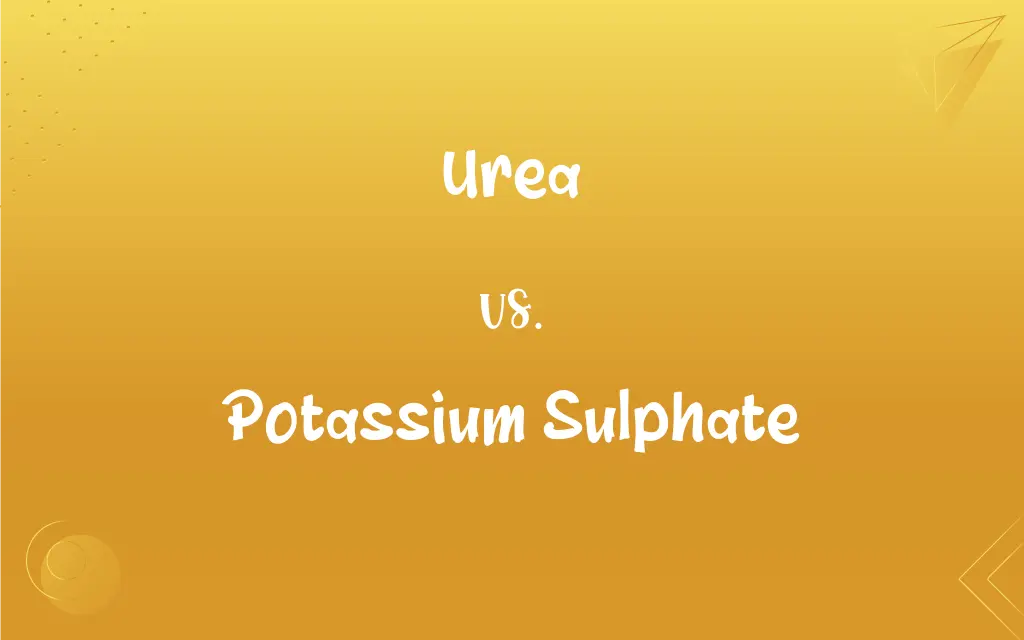Urea vs. Potassium Sulphate: What's the Difference?
Edited by Aimie Carlson || By Janet White || Published on March 5, 2024
Urea is a nitrogen-rich fertilizer enhancing plant growth, whereas potassium sulphate is a source of potassium, improving plant resistance and fruit quality without affecting soil acidity.

Key Differences
Urea, with a high nitrogen content, is crucial for promoting vegetative growth in plants, making it a popular choice for crops requiring significant nitrogen. Potassium sulphate, offering potassium and sulfur, supports photosynthesis, fruit quality, and resistance to diseases. While urea focuses on leafy growth and protein synthesis in plants, potassium sulphate is key for overall plant health and development of fruits and flowers.
The application of urea can lead to a rapid increase in soil nitrogen levels, sometimes causing nitrogen leaching if not managed properly. Potassium sulphate, on the other hand, is less likely to alter soil pH or lead to nutrient imbalances, making it suitable for sensitive crops and soils. Urea's volatilization into ammonia gas can be a concern, requiring careful timing and methods of application to minimize losses. Potassium sulphate’s stability and solubility make it easier to manage, with less risk of loss to the environment.
Urea is synthesized from ammonia and carbon dioxide, representing a significant achievement in agricultural science for its role in boosting crop yields globally. Potassium sulphate is mined from mineral sources or synthesized from potassium chloride and sulfuric acid, providing essential nutrients in a form readily available to plants. The choice between urea and potassium sulphate depends on the specific nutritional needs of the crop, soil health, and environmental considerations, with urea suited for rapid nitrogen supplementation and potassium sulphate for improving quality and stress resistance.
Comparison Chart
Primary Nutrient
Nitrogen
Potassium and Sulfur
Role in Plant Growth
Promotes vegetative growth and protein synthesis
Supports photosynthesis, improves fruit quality and disease resistance
ADVERTISEMENT
Soil Impact
Can increase soil acidity, risk of nitrogen leaching
Minimal impact on soil pH, less risk of nutrient imbalance
Application Concerns
Risk of volatilization, requires careful application
Stable, easier to manage with less environmental risk
Source
Synthetic, from ammonia and CO2
Mined or synthesized from KCl and sulfuric acid
Urea and Potassium Sulphate Definitions
Urea
Can lead to soil acidification if overused.
Excessive urea application requires lime to balance soil pH.
Potassium Sulphate
Soluble, with minimal environmental impact.
It's a preferred choice for environmentally conscious farming.
ADVERTISEMENT
Urea
Synthetic, made from ammonia and CO2.
Urea production is a major industrial process for agriculture.
Potassium Sulphate
Does not affect soil acidity like other fertilizers.
Ideal for neutral pH soils requiring potassium.
Urea
Highly soluble, but prone to volatilization.
Urea needs incorporation into soil to prevent nitrogen loss.
Potassium Sulphate
Enhances fruit quality and disease resistance.
Applied to tomatoes for improved taste and firmness.
Urea
A nitrogen-rich fertilizer boosting leaf growth.
Urea is applied to wheat to enhance its vegetative growth.
Potassium Sulphate
Sourced from mineral deposits or chemical synthesis.
Potassium sulphate is often mined from polyhalite.
Urea
Vital for protein synthesis in plants.
Urea application increases protein content in legumes.
Potassium Sulphate
Provides potassium and sulfur, essential for crops.
Potassium sulphate is used on fruit trees for better yield.
Urea
A water-soluble compound, CO(NH2)2, that is the major nitrogenous end product of protein metabolism and is the chief nitrogenous component of the urine in mammals and certain other animals. Also called carbamide.
Urea
A water-soluble organic compound, CO(NH2)2, formed by the metabolism of proteins and excreted in the urine.
Urea
Any N-substituted derivative of urea, with the general formula (R1R2N)CO(NR3R4).
Urea
A very soluble crystalline body which is the chief constituent of the urine in mammals and some other animals. It is also present in small quantity in blood, serous fluids, lymph, the liver, etc.
Urea
The chief solid component of mammalian urine; synthesized from ammonia and carbon dioxide and used as fertilizer and in animal feed and in plastics
FAQs
How do urea and potassium sulphate impact the environment?
Urea can contribute to nitrogen leaching and volatilization, while potassium sulphate has minimal environmental impact due to its stability.
Why is potassium sulphate important for plants?
It provides potassium for photosynthesis and sulfur for protein synthesis, enhancing fruit quality and stress resistance.
Can urea affect soil pH?
Yes, excessive use of urea can lead to soil acidification, necessitating lime to neutralize the pH.
Is potassium sulphate better than urea?
Not necessarily better, but it serves different nutritional needs, focusing on potassium and sulfur rather than nitrogen.
Can I mix urea and potassium sulphate together?
They can be applied together if balanced correctly, addressing both nitrogen and potassium deficiencies without causing nutrient imbalance.
What is urea used for in agriculture?
Urea is primarily used as a nitrogen fertilizer to promote vegetative growth and increase crop yields.
What crops benefit most from potassium sulphate?
Fruits, vegetables, and flowers that require high potassium levels and are sensitive to chloride found in other potassium fertilizers.
How do soil conditions affect the efficacy of urea and potassium sulphate?
Urea is best used in moist soil to reduce volatilization, while potassium sulphate's effectiveness is less dependent on soil moisture but may vary with soil composition.
When should I use urea fertilizer?
Use urea when crops need a quick boost in nitrogen, especially during the early stages of vegetative growth.
What are the storage requirements for urea and potassium sulphate?
Urea requires storage in a dry, cool place to prevent caking and degradation. Potassium sulphate is less hygroscopic and can be stored more flexibly, but also benefits from dry conditions.
What measures can reduce environmental risks from urea?
Proper application timing, using slow-release formulations, and combining with nitrification inhibitors can minimize leaching and volatilization.
How does urea volatilization occur?
When urea is not incorporated into the soil, it can convert to ammonia gas and be lost to the atmosphere, especially in warm, moist conditions.
Can urea and potassium sulphate be used in organic farming?
Urea is generally not permitted in organic farming due to its synthetic origin, whereas natural forms of potassium sulphate may be used under specific organic standards.
What safety precautions should be taken when applying urea and potassium sulphate?
Wear protective clothing and avoid inhalation of dust. Urea can cause skin irritation, and potassium sulphate may also irritate eyes and skin on contact.
Can the application of urea and potassium sulphate affect nearby water bodies?
Yes, runoff from over-applied fertilizers can lead to nutrient pollution in waterways, contributing to eutrophication and harmful algal blooms.
What advancements are being made in the formulation of urea and potassium sulphate fertilizers?
Innovations include controlled-release urea coatings to reduce volatilization and enhance nitrogen use efficiency, and fortified potassium sulphate products with micronutrients for broader nutritional support.
What are the signs of nitrogen deficiency that urea can address?
Yellowing of older leaves and stunted growth are common signs, which urea application can quickly correct by providing nitrogen.
How do potassium sulphate applications benefit drought-prone areas?
Potassium improves water use efficiency and drought resistance in plants, making potassium sulphate valuable in arid regions.
How does the cost of urea compare to potassium sulphate?
Urea is typically less expensive per unit of nitrogen than potassium sulphate is per unit of potassium, reflecting production costs and the availability of raw materials.
How do urea and potassium sulphate fit into a balanced fertilization program?
They should be used as part of a comprehensive soil management plan, considering soil tests and specific crop needs to avoid nutrient imbalances.
About Author
Written by
Janet WhiteJanet White has been an esteemed writer and blogger for Difference Wiki. Holding a Master's degree in Science and Medical Journalism from the prestigious Boston University, she has consistently demonstrated her expertise and passion for her field. When she's not immersed in her work, Janet relishes her time exercising, delving into a good book, and cherishing moments with friends and family.
Edited by
Aimie CarlsonAimie Carlson, holding a master's degree in English literature, is a fervent English language enthusiast. She lends her writing talents to Difference Wiki, a prominent website that specializes in comparisons, offering readers insightful analyses that both captivate and inform.































































